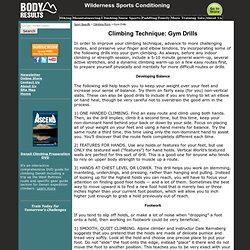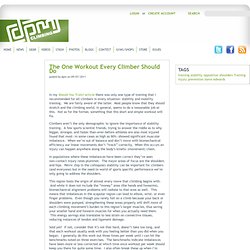

Rock and Ice Climbing Training Program Development. Wilderness Sports > Rock & Ice Climbing > Rock and Ice Climbing Training Program Development Alpine rock and ice climbing require cardiovascular endurance (via anaerobic training), total body strength (through strength conditioning), a high degree of flexibility (via flexibility training), sport-specific skill, and cross-training for muscle balance.

While being in strong physical condition is important for success on a trip, even more crucial for the alpinist is appropriate development of sport-specific skills. The five major fitness qualities your general training should focus on are: Climbing Technique: Gym Drills. Sport Specific > Climbing-Rock > Gym Drills In order to improve your climbing technique, advance to more challenging routes, and preserve your finger and elbow tendons, try incorporating some of the following drills into your gym climbing.

As always, before any indoor climbing or strength session, include a 5-10 minute general warm-up, several active stretches, and a dynamic climbing warm-up on a few easy routes first, to prepare yourself physically and mentally for more difficult routes or drills. Developing Balance The following will help teach you to keep your weight over your feet and increase your sense of balance. Try them on fairly easy (for you) non-vertical slabs. Rock climbing techniques, rock climbing guide, Rock climbing information, rock climbing book. Pro tips - slopers. Home Climbing Gym aka The Boulder Box. The One Workout Every Climber Should Do - Rock Climbing & Bouldering Articles. Posted by dpm on 09/07/2011 In my Should You Train?

Article there was only one type of training that I recommended for all climbers in every situation: stability and mobility training. We are fairly aware of the latter. Most people know that they should stretch and the climbing world, in general, seems to do a reasonable job at this. Not so for the former, something that this short and simple workout will fix. Climbers aren’t the only demographic to ignore the importance of stability training. In populations where these imbalances have been correct they’ve seen non-contact injury rates plummet. This region hosts the origin of almost every move that climbing begins with. Sold yet? The Warm-up If you’ve been climbing or training you can skip these exercises. Halos Using a dumbbell, kettlebell, or medicine ball (or rock, etc), stand erect holding the weight in front of you at chest to neck level with naturally-bent arms.
Do 10 in each direction Snatch Do 15 Skiers The Workout. Eric Hörst's Training For Climbing. Training to Become a Better Climber - Part 1. More Articles Like This Is it possible to improve your climbing without even trying?

Jack Geldard thinks that a few small changes in your climbing... [ full article ] Top British Boulderer, Ned Feehally shares his experiences climbing some hard boulders both in the UK and the world, his opinions... [ full article ] In this short video from Canadian competition climber Sean McColl, we see Sean training at a private wall in Chamonix, France. ... [ full article ] Popular Articles Right Now Finger Injuries are almost certainly the most common injuries climbers face. With junior competitions becoming more popular, training for young climbers is becoming much more popular.
Related UKC Forum discussions This is the first of a series of training articles and is aimed at beginners or people who are operating in the low grades and wish to improve (Approximate grade range of around UK Diff - Severe, Sport grade F3 - 4 or bouldering grade VB / UK Tech 4c). Name: Tommy Toprope Footwork – The Basics. Rock and Ice.com. Salus - Mountaineering Safety Tool by Malcolm Russell. Simple Safety for Mountain Climbers Designer Malcolm Russell’s innate affinity for rock climbing is the source of inspiration for his latest design, Salus, a mountaineering safety tool that makes for quick and concise correspondence between climbing partners.

The lightweight device latches onto the user’s harness and uses simple colored lights as basic commands, providing a safe and easy way to communicate invaluable information like danger warnings or a notification of a successful climb. The solid Perspex lights have been sandblasted to soften the light, and the casing has been manufactured using PVC toughened plastic for roughness and durability.
Designer: Malcolm Russell.